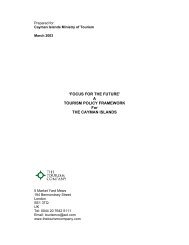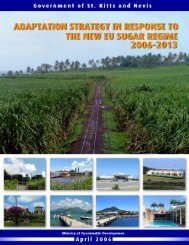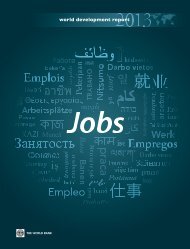Business Removing
Doing Business in 2005 -- Removing Obstacles to Growth
Doing Business in 2005 -- Removing Obstacles to Growth
- No tags were found...
You also want an ePaper? Increase the reach of your titles
YUMPU automatically turns print PDFs into web optimized ePapers that Google loves.
42 DOING BUSINESS IN 2005<br />
The rationale for such arrangements is that borrowers<br />
need protection. The irony is that they hurt the very<br />
people they are meant to protect. Insiders can always get<br />
loans. But high-risk borrowers—most start-ups, small<br />
firms, poor people—will not get a loan at a capped interest<br />
rate. Nor if they cannot offer their main business<br />
assets as collateral. They will be refused credit.<br />
Borrower protections often backfire. Introduce<br />
strong ones and there will be no borrowers to protect.<br />
Take the Maldives. After a few years of successful development<br />
of mortgage lending, politicians thought it<br />
would be a popular reform to prohibit creditors from<br />
seizing the primary residence in case of default. Within<br />
months the mortgage market dried up. (In April 2004<br />
the law was amended to address some of its weaknesses).<br />
Bankruptcy receives a lot of attention in reform<br />
proposals for improving access to credit. Yet bankers<br />
and corporate lawyers estimate that more than threequarters<br />
of collateral enforcement takes place outside of<br />
bankruptcy. In poor countries, more than 90%. This<br />
may decrease if bankruptcy were more efficient. But<br />
even in countries with the most efficient insolvency, the<br />
majority of creditors enforce outside of bankruptcy.<br />
Credit markets work best with an effective assessment of<br />
the borrower’s credit history, an ability to use a wide<br />
range of assets as collateral cheaply, and enforcement of<br />
collateral out of court. This is where Albania, India and<br />
Latvia have focused their reform efforts.<br />
Who is increasing access to credit?<br />
Sharing credit information<br />
Twenty-five years ago, only a third of countries had either<br />
a private bureau, a public registry or both. Today 80% do.<br />
The growth in poor and middle income countries has<br />
been dramatic, with 37 new public registries and 23 private<br />
bureaus, mainly in Latin America, East Asia and<br />
Central and Eastern Europe. But poorer countries still lag<br />
well behind rich ones, especially in information sharing<br />
through private bureaus (figure 6.2, table 6.1).<br />
Credit registries are useful to lenders only if they<br />
distribute a broad range of high quality and easily accessible<br />
data. Fourteen countries have credit information<br />
systems with:<br />
• Both positive information, meaning loans outstanding,<br />
assets, payment behavior on accounts in good<br />
standing—as well as negative information, meaning<br />
defaults and arrears.<br />
• Data on both firms and individuals.<br />
• Data from retailers, or utilities as well as financial<br />
institutions.<br />
• Five or more years of historical data preserved.<br />
• Data on all loans above 1% of income per capita.<br />
• Legal guarantees for the consumer’s right to inspect<br />
their data.<br />
These are Argentina, Belgium, Brazil, Chile, Germany,<br />
Italy, Japan, Malaysia, Mexico, Paraguay, Peru, Spain, the<br />
United Kingdom and the United States.<br />
But in many other countries, credit information is<br />
limited—21 have at most 2 of these features including<br />
Ghana, Morocco, the Philippines, Serbia and Montenegro,<br />
Sri Lanka and Yemen. And 25 countries have no<br />
FIGURE 6.2<br />
Scant private information sharing in poor countries<br />
Presence and coverage of credit information registries<br />
90<br />
Presence<br />
(percentage of countries)<br />
60<br />
60<br />
57<br />
33<br />
Source: Doing <strong>Business</strong> database.<br />
Private bureau<br />
21 Poor 47<br />
Middle<br />
income<br />
Rich<br />
Public registry<br />
Poor 14<br />
Middle<br />
income<br />
65<br />
Rich 68<br />
Coverage<br />
(borrowers per 1,000 adults)<br />
information sharing including Albania, Ethiopia, Jamaica,<br />
the Kyrgyz Republic, Malawi, Papua New Guinea,<br />
Russia and Syrian.<br />
Reforms of registries focused on 5 areas:<br />
• Providing data online. The bureaus in Bosnia and<br />
Herzegovina and Spain—as well as the Brazilian, Belgian,<br />
Mozambican, Pakistani and Portuguese public registries—launched<br />
online systems. Creditors can now obtain<br />
information instantly. In most countries it used to<br />
take more than a week. Bangladesh and Bulgaria plan to<br />
launch online access in late 2004.<br />
• Sharing positive information. The public registries in<br />
Belgium, Brazil and Turkey began sharing more positive<br />
information. Backed by new laws, the Greek and Hong<br />
Kong (China) private bureaus did the same. In Greece<br />
the number of consultations to the bureau grew by more<br />
223<br />
499

















